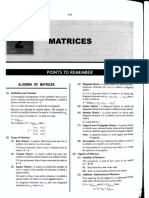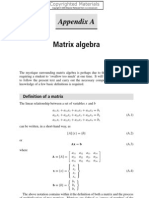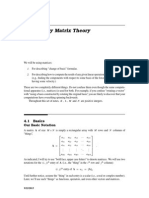How To Matrix
Uploaded by
Mohamed ElmaadawyHow To Matrix
Uploaded by
Mohamed ElmaadawyM.
Vable
Intermediate Mechanics of Materials: Appendices
August 2nd, 2005
Appendix D: Basic Matrix Algebra
This appendix briey reviews basic matrix algebra from a perspective of this book. The presentation presupposes you are familiar with the concepts. You may need to review your mathematics book for additional details.
D.1 Basic Denitions
A rectangular array of numbers is called a matrix. The matrix shown in Equation (D.1) has m rows and n columns. The size of the matrix is said to be (m x n).The element in the ith row and jth column is represented by aij. a 11 [A] = a 21 a 12 a 22 a 1n a 2n a mn (D.1)
a m1 a m2
D.2 Addition of Matrices
Addition of matrices can only be performed for matrices having the same number of rows and columns. The sum of two matrices [A] and [B] of m rows and n columns results in a matrix [C] of m rows and n columns and is represented by Equation (D.2a). [C] = [A] + [B] The elements of the matrix [C] can be found using Equation (D.2b). c ij = a ij + b ij i = 1, 2 m j = 1, 2 n (D.2a)
(D.2b)
D.3 Multiplication of Matrices
Multiplication of a matrix by a number results in a matrix where all elements are multiplied by the number as shown in Equation (D.3). a 11 q[A] = q a 21 a 12 a 22 a 1n a 2n a mn = qa 11 qa 12 qa 21 qa 22 qa m1 a m2 qa 1n qa 2n qa mn (D.3)
a m1 a m2
468
M. Vable
Intermediate Mechanics of Materials: Appendices
August 2nd, 2005
The order of multiplication is important when two matrices are multiplied. In Equation (D.4a), matrix [A] is said to pre-multiply matrix [B] and matrix [B] is said to post-multiply matrix [A]. [C] = [A][B] (D.4a) In Equation (D.4a) the number of columns of matrix [A] must equal to number of rows of matrix [B]. If matrix [A] of size (m x n) pre-multiplies matrix [B] of size (n x p), the result is a matrix [C] of size (m x p). The elements of matrix [C] can be found from
c ij =
aik bkj
k=1
i = 1, 2 m j = 1, 2 p
(D.4b)
D.4 Matrix and its Transpose
The transpose of a rectangular matrix [A] consisting of m rows and n columns is written as [A]T and are related as shown in Equation (D.5). a 11 [A] = a 21 a 12 a 22 a 1n a 2n a mn [A] =
T
a 11 a 12 a 1n
a 21 a 22 a 2n
a m1 a m2 a mn (D.5)
a m1 a m2
The element aij of matrix [A] becomes element aji in the transposed matrix [A]T. A square matrix (same number of rows and columns) is said to be symmetric if the transpose of the matrix is the same as the original matrix as shown in Equation (D.6) Symmetric Matrix [A] = [A] (D.6) Equation (D.7) lists the rules that apply to transpose of matrices during addition and multiplications. ([A] + [B]) = [A] + [B]
T T T T
([A][B]) = [B] [A]
(D.7)
469
M. Vable
Intermediate Mechanics of Materials: Appendices
August 2nd, 2005
D.5 Determinant of a Matrix
Determinant is dened only for a square matrix and is represented as shown in Equation (D.8). a 11 A = det [ A ] = a 21 a n1 a 12 a 22 a n2 a 1n a 2n a nn (D.8)
The minor Mij associated with a element aij is the determinant of the matrix in which the ith row and jth column have been removed. The determinant of a matrix can be found using Equation (D.9) where i is any row in the matrix or it can be found using Equation (D.10) where j is any column in the matrix.
A =
( 1 )
k=1
i+k
a ik M ik
(D.9)
A =
( 1 )
k=1
k+j
a kj M kj
(D.10)
If the determinant of a matrix is zero i.e., A = 0 then the matrix [A] is said to be singular. In a singular matrix either all rows are not independent or all columns are not independent.
D.6 Cramers Rule
Cramers rule can be used for solving a set of linear algebraic equations. Consider the set of n linear algebraic equations in matrix form shown in Equation (D.11). a 11 a 21 a n1 a 12 a 22 a n2 a1 j a2 j a jj a nj x1 r1 a 1n r2 a 2n x 2 = xj rj r a nn x n n
(D.11)
By Cramers rule the jth unknown xj can be found by rst replacing the jth column by the right
470
M. Vable
Intermediate Mechanics of Materials: Appendices
August 2nd, 2005
hand side vector, taking the determinant of the resulting matrix, and then dividing by the determinant of the matrix [A] as shown in Equation (D.12) a 11 a 21 a 12 a 22 r1 r2 rj a 1n a 2n (D.12)
a n1 a n2 rn a nn x j = ----------------------------------------------------------------------------------------A
j = 1, 2 n
D.7 Inverse of a Matrix
Inverse of a matrix can be found only of a square matrix. The inverse of a matrix [A] is denoted by [A]-1. The product of a matrix and its inverse results in an identity matrix [I] as shown in Equation (D.13). The identity matrix [I] has one for the diagonal elements and all off-diagonal elements are zero. [A] [A] = [A][A] = [I] Equation (D.11) in matrix form can be written as Equation (D.14a).
1 1
(D.13)
[A]{x} = {r } (D.14a) where, {x} represents the unknown vector with components xj and {r} represents the right hand side vector with components rj. By pre-multiplying by [A]-1 to both sides of Equation (D.14a) and using Equation (D.13) we obtain the unknown vector as shown in Equation (D.14b) [A] [A]{x} = [A] {r }
1 1
or
1
[I]{x} = [A] {r }
or (D.14b)
{x} = [A] {r}
471
You might also like
- Math 225 Linear Algebra II Lecture Notes: John C. Bowman University of Alberta Edmonton, CanadaNo ratings yetMath 225 Linear Algebra II Lecture Notes: John C. Bowman University of Alberta Edmonton, Canada61 pages
- The Physics of Zombies: Madore's Rules of Zombie Cohesion, Zombie Cells and Super Cells, Zombie Black Holes, Zombie Cell Stress-Fission and Zombie Quirks100% (1)The Physics of Zombies: Madore's Rules of Zombie Cohesion, Zombie Cells and Super Cells, Zombie Black Holes, Zombie Cell Stress-Fission and Zombie Quirks19 pages
- PETE-560 Mathematical Methods in Petroleum Engineering Lecture Notes Chapter # 5 6.1 Linear AlgebraNo ratings yetPETE-560 Mathematical Methods in Petroleum Engineering Lecture Notes Chapter # 5 6.1 Linear Algebra50 pages
- I.Rajkumar: Introduction To Finite Elements of AnalysisNo ratings yetI.Rajkumar: Introduction To Finite Elements of Analysis67 pages
- 214623B.C.Amathematics2nd Sem Matrix and Determinant 13 04 2020No ratings yet214623B.C.Amathematics2nd Sem Matrix and Determinant 13 04 202039 pages
- 214623B.C.amathematics2nd Sem Matrix and Determinant 13-04-2020No ratings yet214623B.C.amathematics2nd Sem Matrix and Determinant 13-04-202039 pages
- Linear Algebra Primer: Daniel S. Stutts, PH.DNo ratings yetLinear Algebra Primer: Daniel S. Stutts, PH.D14 pages
- JEE Main 2022 Maths Revision Notes On Matrices and DeterminantsNo ratings yetJEE Main 2022 Maths Revision Notes On Matrices and Determinants7 pages
- Introduction To Matrices: 2.14 Analysis and Design of Feedback Control SystemsNo ratings yetIntroduction To Matrices: 2.14 Analysis and Design of Feedback Control Systems9 pages
- Matrix Theory and Applications for Scientists and EngineersFrom EverandMatrix Theory and Applications for Scientists and EngineersNo ratings yet
- Optimal and Robust Design of Docking BlocksNo ratings yetOptimal and Robust Design of Docking Blocks12 pages
- Chem 373 - Lecture 27: Homonuclear Diatomic Molecules-IINo ratings yetChem 373 - Lecture 27: Homonuclear Diatomic Molecules-II22 pages
- Eurocode 4 Seminar Composite Structures Composite Slabs With Profiled Steel Sheeting100% (1)Eurocode 4 Seminar Composite Structures Composite Slabs With Profiled Steel Sheeting23 pages
- Class 11 Cbse Maths Sample Paper Model 2No ratings yetClass 11 Cbse Maths Sample Paper Model 22 pages
- Trimcbcv Calculation Methods For A Dynamical Model of The Remus 100 AUVNo ratings yetTrimcbcv Calculation Methods For A Dynamical Model of The Remus 100 AUV56 pages
- Michael Levin and Xiao-Gang Wen - Fermions, Strings, and Gauge Fields in Lattice Spin ModelsNo ratings yetMichael Levin and Xiao-Gang Wen - Fermions, Strings, and Gauge Fields in Lattice Spin Models10 pages
- Mechanical Vibrations (ME65) Session 8 Date: (23/3/07)No ratings yetMechanical Vibrations (ME65) Session 8 Date: (23/3/07)12 pages
- A New Handling System For Textile/clothing Industry: July 2010No ratings yetA New Handling System For Textile/clothing Industry: July 20107 pages
- AP Physics B Electrostatics Coulomb Law Test of TimingNo ratings yetAP Physics B Electrostatics Coulomb Law Test of Timing3 pages
- Ions in Actions: Grade 9 Science - Laboratory Activity 1.1No ratings yetIons in Actions: Grade 9 Science - Laboratory Activity 1.13 pages
- Math 225 Linear Algebra II Lecture Notes: John C. Bowman University of Alberta Edmonton, CanadaMath 225 Linear Algebra II Lecture Notes: John C. Bowman University of Alberta Edmonton, Canada
- The Physics of Zombies: Madore's Rules of Zombie Cohesion, Zombie Cells and Super Cells, Zombie Black Holes, Zombie Cell Stress-Fission and Zombie QuirksThe Physics of Zombies: Madore's Rules of Zombie Cohesion, Zombie Cells and Super Cells, Zombie Black Holes, Zombie Cell Stress-Fission and Zombie Quirks
- PETE-560 Mathematical Methods in Petroleum Engineering Lecture Notes Chapter # 5 6.1 Linear AlgebraPETE-560 Mathematical Methods in Petroleum Engineering Lecture Notes Chapter # 5 6.1 Linear Algebra
- I.Rajkumar: Introduction To Finite Elements of AnalysisI.Rajkumar: Introduction To Finite Elements of Analysis
- 214623B.C.Amathematics2nd Sem Matrix and Determinant 13 04 2020214623B.C.Amathematics2nd Sem Matrix and Determinant 13 04 2020
- 214623B.C.amathematics2nd Sem Matrix and Determinant 13-04-2020214623B.C.amathematics2nd Sem Matrix and Determinant 13-04-2020
- JEE Main 2022 Maths Revision Notes On Matrices and DeterminantsJEE Main 2022 Maths Revision Notes On Matrices and Determinants
- Introduction To Matrices: 2.14 Analysis and Design of Feedback Control SystemsIntroduction To Matrices: 2.14 Analysis and Design of Feedback Control Systems
- Matrix Theory and Applications for Scientists and EngineersFrom EverandMatrix Theory and Applications for Scientists and Engineers
- Chem 373 - Lecture 27: Homonuclear Diatomic Molecules-IIChem 373 - Lecture 27: Homonuclear Diatomic Molecules-II
- Eurocode 4 Seminar Composite Structures Composite Slabs With Profiled Steel SheetingEurocode 4 Seminar Composite Structures Composite Slabs With Profiled Steel Sheeting
- Trimcbcv Calculation Methods For A Dynamical Model of The Remus 100 AUVTrimcbcv Calculation Methods For A Dynamical Model of The Remus 100 AUV
- Michael Levin and Xiao-Gang Wen - Fermions, Strings, and Gauge Fields in Lattice Spin ModelsMichael Levin and Xiao-Gang Wen - Fermions, Strings, and Gauge Fields in Lattice Spin Models
- Mechanical Vibrations (ME65) Session 8 Date: (23/3/07)Mechanical Vibrations (ME65) Session 8 Date: (23/3/07)
- A New Handling System For Textile/clothing Industry: July 2010A New Handling System For Textile/clothing Industry: July 2010
- AP Physics B Electrostatics Coulomb Law Test of TimingAP Physics B Electrostatics Coulomb Law Test of Timing
- Ions in Actions: Grade 9 Science - Laboratory Activity 1.1Ions in Actions: Grade 9 Science - Laboratory Activity 1.1






























































































